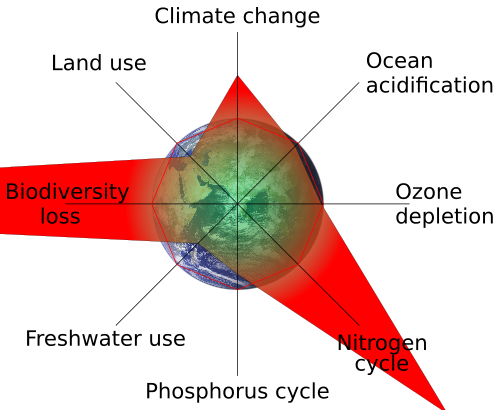During a recent visit to the International Water Management Institute, Johan Rockström discusses the Planetary Boundary Framework with the Water, Land and Ecosystems team.
This image highlights the 3 planetary boundaries that have already been breached.
Source: Wikimedia Commons
Human activities have been tampering with the global environment for centuries now. Human nature might very well be throwing mother nature out the window. Many believe that, thanks to human activities that are changing global environmental systems, we have created a new geological era known as the Anthropocene. Not sold on this claim yet? Read the news. The atmospheric composition has changed, the Arctic is melting, sea levels are rising, natural disasters are occurring with greater intensity, weather patterns have become entirely unpredictable in some areas.
For the past 10,000 years humans have enjoyed living in what is known as the Holocene. However, many believe that we are in the process of exiting the stable Holocene epoch and entering a new era called the Anthropocene, where as Rockström states, "humans are becoming a geological force of change." In an effort to determine exactly how far we can drive environmental change until we reach a point of no return, Johan Rockström and his colleagues set out to define what are known as the planetary boundaries. These nine boundaries define limits to human induced environmental change within the Holocene, before we reach an area of uncertainty and irreversible damage.
See Part 2 of this video to learn more about Rockstrom's new book, The Human Quest, and the paradigm shift that will be necessary for humans to live within the planetary boundaries.
Johan Rockström is the Executive Director of the Stockholm Resilience Centre and is a professor at Stockholm University. He is one of the world's leading scientists on global sustainability issues and was named "Swede of the Year" in 2009 for his work.
Interview conducted by James Clarke, Head of Communications, International Water Management Institute.







/index.jpg?itok=EzuBHOXY&c=feafd7f5ab7d60c363652d23929d0aee)











Comments
Thrilling to see Johan and his cohort visiting IMWI, the planetary boundaries paper is ground-breaking, and with very little interpretation we quickly recognize the the CGIAR SLO's, in addition to being critical to the poor, is really a global mandate.
planetary boundaries do not always materially impact the end result, specially when properly analyzed. Thanks for sharing. Thank you for the article Water.